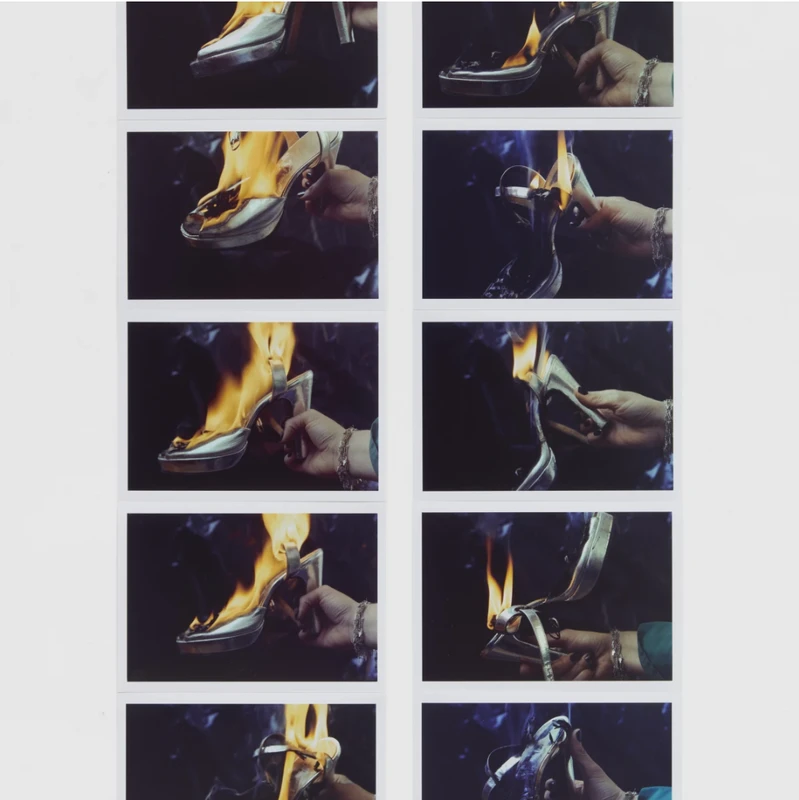Alexis Hunter: 10 Seconds | Curated by Natasha Hoare
6 Feb-30 Mar 2024
PV 6 Feb 2024


‘…I set up the narrative sequences to work as advertising does, within a minimum of ten seconds.’ - Alexis Hunter
Richard Saltoun Gallery presents a solo exhibition of works by Alexis Hunter (1948-2014), a pivotal figure in the British Feminist Movement of the 1970s, marking the gallery’s representation of her estate. Curated by Natasha Hoare, Senior Curator at Goldsmiths CCA, 10 Seconds compliments Hunter's presence in the exhibition at Tate Britain, Women in Revolt!: Art, Activism and the Women’s movement in the UK 1970–1990. This will be the most extensive display of Hunter’s works since the acclaimed exhibition Sexual Warfare at Goldsmiths CCA in 2018.
10 Seconds focuses on Hunter’s most iconic works produced in the 1970’s, when she was an active part of the Feminist movement. She was working in photography to produce photo-narrative sequences that questioned gender stereotypes and patriarchal image culture, including famous series such as Domestic Warfare (1975) and Approaches to Fear (1977). Esteemed art critic, Lucy Lippard, writes about Hunter’s works from this period: "Fetishism and a hint of S&M lurk just beneath the surfaces of Hunter's photographs … Her rage at capitalism is focused upon the mass media which have, as Judith Williamson puts it, been 'selling us ourselves' for profit."
Recognising the pernicious effect of advertising in promulgating gender norms, Hunter devised the photo narratives to unfold over a minimum of ten seconds, mirroring the space of attention of watching a TV advert. The exhibition draws attention to Hunter’s relationship to moving image and mass media, disrupting the conventions of both to stage ambiguous unfolding scenes that interplay desire, liberation, containment, and violence. These works remain relevant at a time in which women’s equality remains unrealised in many areas of life and is unevenly distributed.
The photo narratives, made up of grids of photographic images that lead sequentially from action to action, demonstrate her engagement with conceptual art, feminist film theory, psychoanalysis and socialism, as part of a collective conversation with fellow artists, curators, and activist groups. The works strain towards the medium of film, which Hunter had worked in previously but rejected as being too resource heavy to produce. Hunter used photography for its instantaneity, and reference to both TV and women’s magazine adverts. It was central to her to use a visual language that could be read by audiences outside of the confines of an elitist and male dominated art world.
Typically featuring red nail varnished hands performing various actions, the works demand that we read the unfolding actions from a woman protagonists’ perspective; a radical rejoinder to a visual culture built on the male gaze. They are however anything but didactic, leaving room for visceral response and multiple interpretations. Images show stiletto shoes on fire, a wall being demolished, and grease covered hands caressing motor parts, in what can be read as incisive political critiques of misogyny, capitalism’s deployment of gender as a facet of consumer society, but also as an exploration of the deep fears and anxieties that underwrite embattled relationships between men and women, and women’s nascent self-realisation.
About Natasha Hoare
Natasha Hoare is Senior Curator at Goldsmiths Centre for Contemporary Art, London, since 2018. She was previously Curator at Kunstinstituut Melly (Formerly known as Witte de With) Rotterdam. She has contributed to Art Review, Frieze Magazine, Flash Art International and Elephant Magazine, and is the author of The New Curator (Laurence King, 2016).